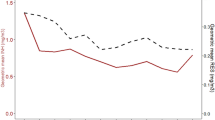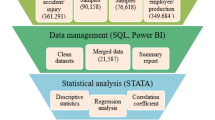Abstract
Objectives
Starting shortly after the reunification of Germany and lasting up to the end of the 1990s, an extensive series of retrospective exposure investigations for the East German uranium mining industry was performed in order to provide information about the exposure situation of the miners towards respirable dust, inhalable dust, crystalline silica and heavy metals. It should provide the necessary information for legal compensation of miners with potential industrial diseases as well as for epidemiological research.
Methods
Extensive side-by-side measurements using original historic equipments as well as comprehensive evaluation of the time increments of specific jobs with respect to exposure relevant tasks were performed. After attributing average exposures to the tasks, shift exposures for the jobs could be calculated.
Results
By the end a comprehensive job exposure matrix for all underground jobs of the German uranium mining industry was developed for the components mentioned, including arsenic where relevant. In the early days of SAG/SDAG Wismut dust and silica exposures were extremely high with respirable dust up to 20 mg/m3 and respirable crystalline silica well above 2 mg/m3 as shift averages. Beginning from about the early 1960s dust control measures started to improve conditions dramatically.
Conclusions
It is absolutely necessary to invest sufficient effort for the estimation of exposure situations of past technological environments. Especially, the situation of early mechanised mining, characterised by low ventilation, dry drilling techniques and generally lacking dust control measures was characterized by extreme shift exposures. It is important to keep these in mind when metal mining exposure in different environments is considered.






Similar content being viewed by others
Notes
Staatlichen Aktiengesellschaft der Buntmetallindustrie »Wismut«/Sowjetisch Deutsche Aktiengesellschaft Wismut.
References
Bauer H-D (1997) Staubbelastungen in untertägigen Betrieben der ehemaligen Wismut während der Frühphase der Uranerzgewinnung nach dem 2. Weltkrieg. Gefahrstoffe-Reinhaltung der Luft 57:349–354
Bauer H-D (2000) Studie zur retrospektiven analyse der Belastungssituation im Uranerzbergbau der ehemaligen SDAG Wismut mit Ausnahme der Strahlenbelastung für die Zeit von 1946 bis 1990. HVBG, St. Augustin
Bauer H-D, Stoyke G (2004) Erstellung von Dokumentationsunterlagen für eine JOB-exposure matrix bezogen auf Arsen-Belastungen bei Tätigkeiten in Betrieben der ehemaligen SAG/SDAG Wismut für die Zeit von 1946 bis 1990. HVBG, St Augustin
Bauer H-D, Stoyke G (2005) Die Arsenproblematik in Betrieben der ehemaligen SAG/SDAG Wismut. Kompass 115:6–12
Bauer H-D, Dahmann D, Stoyke G (1998) Vergleichsmessungen zwischen Konimetrie und gravimetrischer Feinstaubprobenahme in Uranerzlagerstätten von Sachsen und Thüringen. Gefahrstoffe-Reinhaltung der Luft 58:153–159
Dahmann D, Hartfiel G-D, Jackisch J (2001) Intercomparison and performance of stationary aerosol samplers. Gefahrstoffe-Reinhaltung der Luft 61:201–206
Dahmann D, Plitzko S, Yang L, Hartfiel G-D, Jackisch J, Thürmer H (2004) Comparison of sampling instruments using DIN EN 13205. Gefahrstoffe—Reinhaltung der Luft 64:345–352
Dahmann D, Taeger D, Kappler M, Büchte S, Morfeld P, Brüning T, Pesch B (2007) Assessment of exposure in epidemiological studies—the example of silica dust. J Expo Sci Environ Epidemiol, in press
EN 481 (1993) Workplace atmospheres: size fraction definitions for measurement of airborne particles. European Committee for Standardization
Lehmann F (1998) Belastung durch ionisierende Strahlung im Uranerzbergbau der ehemaligen DDR. Hauptverband der gewerblichen Berufsgenossenschaften und Bergbau-Berufsgenossenschaft, Meckenheim
Mehlhorn J, Selig R, Pabst R (1992) Zum Silikosegeschehen im Uranerzbergbau der DDR. In: Kreuz P (ed) Arbeitsmedizinische Aspekte der Arbeits (-Zeit) Organisation—Skeletterkrankungen und Beruf. Verhandlung der Deutschen Gesellschaft für Arbeitsmedizin Bd. Gentner, Stuttgart, pp 32:415–419
Messung von Gefahrstoffen-BIA Arbeitsmappe-, Verfahren 8522, Quarz Infrarotspektroskopie 1995
Steenland K, ‘t Mannetje A, Boffetta P, Stayner L, Attfield M, Chen J et al (2001) Pooled exposure-response analyses and risk assessment for lung cancer in 10 cohorts of silica-exposed workers: an IARC multicenter study. Cancer Causes Control 12:773–784
TGL 109–7014, Blatt 1 (1967) Bergbau-Richtlinie zur Staubmessung—Messvorschriften. ZfS Wismut, Ordnungs-Nr. 766.19
TGL 22311/01 (1977) Maximal zulässige Konzentration nicht-toxischer Stäube in der Luft am Arbeitsplatz. ASMW, Berlin
‘t Mannetje A, Steenland K, Checkoway H, Koskela RS, Koponen M, Attfield M et al (2002) Development of quantitative exposure data for a pooled exposure-response analysis of 10 silica cohorts. Am J Ind Med 42:73–86
Verma DK, Sebestyen A, Julian JA, Muir DCF, Schmidt H, Bernholz CD, Shannon HS et al (1989) Silica exposure and silicosis among Ontario hardrock miners: II exposure estimates. Am J Ind Med 16:13–28
Wismut GmbH “Chronik der Wismut” (1999) Wismut GmbH, Jagdschänkenstr. 29, Chemnitz
Zhuang Z, Hearl FJ, Odencrantz J, Chen W, Chen BT, Chen JQ et al (2001) Estimating historical respirable crystalline silica exposures for Chinese pottery workers and iron/copper, tin, and tungsten miners. Ann Occup Hyg 45:631–642
Acknowledgment
The authors thank Hauptverband der gewerblichen Berufsgenossenschaften for financial support.
Author information
Authors and Affiliations
Corresponding author
Additional information
G. Stoyke: Deceased.
Rights and permissions
About this article
Cite this article
Dahmann, D., Bauer, HD. & Stoyke, G. Retrospective exposure assessment for respirable and inhalable dust, crystalline silica and arsenic in the former German uranium mines of SAG/SDAG Wismut. Int Arch Occup Environ Health 81, 949–958 (2008). https://doi.org/10.1007/s00420-007-0287-8
Received:
Accepted:
Published:
Issue Date:
DOI: https://doi.org/10.1007/s00420-007-0287-8




